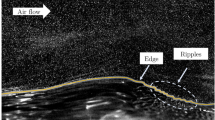Abstract
Experimental results from a study of surface roughness effects on polymer drag reduction in a zero-pressure gradient flat-plate turbulent boundary layer are presented. Both slot-injected polymer and homogeneous polymer ocean cases were considered over a range of flow conditions and surface roughness. Balance measurements of skin friction drag reduction are presented. Drag reductions over 60% were measured for both the injected and homogeneous polymer cases even with fully rough surfaces. As the roughness increased, higher polymer concentration was required to achieve a given level of drag reduction for the homogeneous case. With polymer injection, increasing surface roughness caused the drag reduction to decrease to low levels more quickly when the polymer expenditure was decreased or the freestream velocity was increased. However, the percent drag reductions on the rough surfaces with polymer injection were often substantially larger than on the smooth surface. Remarkably, in some cases, the skin friction drag force on a rough surface with polymer injection was less than the drag force observed on a smooth surface at comparable conditions.

















Similar content being viewed by others
References
Antonia R, Luxton R (1971) The response of a turbulent boundary layer to a step change in surface roughness. J Fluid Mech 48:721–761
Balakirshnan C, Gordon R (1971) New viscoelastic phenomenon and turbulent drag reduction. Nature Phys Sci 213:177–178
Clauser F (1956) In: Dryden H, Von Karman T (eds) Advances in applied mechanics, vol 4. Academic, New York, pp 1–51
Fontaine A, Petrie H, Brungart T (1992) Velocity profile statistics in a turbulent boundary layer with slot-injected polymer. J Fluid Mech 238:435–466
Kato H, Fuji Y, Yamaguchi H, Miyanaga M (1993) Frictional drag reduction by injecting high viscosity fluid into the turbulent boundary layer. Trans ASME JFE 115:206–212
Krogstad P, Antonia R (1999) Surface roughness effects in turbulent boundary layers. Exp Fluids 27:450–460
Madavan N, Deutsch S, Merkle C (1984) Reduction of turbulent skin friction by microbubbles. Phys Fluids 27:356–363
Madavan N, Deutsch S, Merkle C (1985) Numerical investigations into the mechanisms of micro-bubble drag reduction. J Fluids Eng 107:370–377
Merrill E, Smith K, Shin H, Mickley H (1966) Study of turbulent flows of dilute polymer solution in a Couette viscometer. Trans Soc Rheol 10:335–351
Nikuradse J (1933) Stromungsgesetze in rauhen Rohren. Forschungshefte 361, VDI: NACA Technical Mem 1292
Petrie H, Fontaine A, Brungart T (1996) Drag reduction on a flat plate at high Reynolds number with slot-injected polymer solutions. ASME FED Vol 237, Fluids Eng Div Summer Conf Proc 2:3–9
Petrie H, Fontaine A (1996) Comparison of turbulent boundary layer modifications with slot-injected and homogeneous drag-reducing polymer solutions. ASME FED Vol 237, Fluids Eng Div Summer Conf Proc 2:205–211
Poreh M, Cermak J (1964) Study of diffusion from a line source in a turbulent boundary layer. Int J Heat Mass Transfer 7:1083–1095
Raupach M, Antonia R, Rajagopalan S (1991) Rough-wall turbulent boundary layers. Appl Mech Rev 44:1–25
Sedov L, Ioselevich A, Pilipenko V, Vasetskaya N (1979) Turbulent diffusion and degradation of polymer molecules in a pipe and boundary layer. J Fluid Mech 194:561–576
Schultz M, Swain G (1999) The effect of biofilms on turbulent boundary layers. Trans ASME JFE 121:44–51
Smits A, Wood D (1985) The response of turbulent boundary layers to sudden perturbations. Ann Rev Fluid Mech 17:321–358
Spangler J (1969) Studies of viscous drag reduction with polymers including turbulence measurements and roughness effects. In: Wells C.S. (ed) Viscous Drag Reduction. Plenum, New York, pp 131–157
Vdovin A, Smol’yakov A (1978) Diffusion of polymer solutions in a turbulent boundary layer. Zh Prikl Mekh Tekh Fiz 2:66–73. (Transl in UDC 532.526, Plenum, pp 196–201)
Vdovin A, Smol’yakov A (1981) Turbulent diffusion of polymers in a boundary layer. Zh Prikl Mekh Tekh Fiz 4:98–104. (Transl in UDC 532.526 (1982) Plenum, pp 526–531)
Virk P, Mickley H, Smith, K (1970) The ultimate asymptote and mean flow structure in Toms phenomenon. Trans ASME J Appl Mech 37:488–493
Virk P (1971) Drag reduction in rough pipes. J Fluid Mech 45:225–246
Virk P (1975) Drag reduction fundamentals. AIChE J 21:625–656
White F (1974) Viscous fluid flow. McGraw-Hill, New York, pp 490–491
Wu J, Tulin M (1972) Drag reduction by ejecting additive solutions into pure water boundary layer. Trans ASME J Basic Eng 94:749–756
Acknowledgements
This work was supported under subcontract by Cortana Corp., Falls Church, VA.
Author information
Authors and Affiliations
Corresponding author
Additional information
An erratum to this article can be found at http://dx.doi.org/10.1007/s00348-004-0803-5
Rights and permissions
About this article
Cite this article
Petrie, H.L., Deutsch, S., Brungart, T.A. et al. Polymer drag reduction with surface roughness in flat-plate turbulent boundary layer flow. Exp Fluids 35, 8–23 (2003). https://doi.org/10.1007/s00348-003-0589-x
Received:
Accepted:
Published:
Issue Date:
DOI: https://doi.org/10.1007/s00348-003-0589-x




